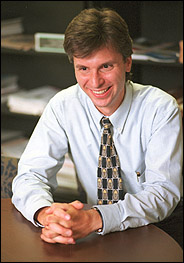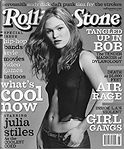Kaleidoscope
Réal Del Degan: The backseat driver
 PHOTO: Owen Egan
PHOTO: Owen Egan |
|
When Réal Del Degan wants to talk to someone, he avoids the phone where possible. "I'm not much for phones; I like to go see people," says the lanky director of the Office of the Vice-Principal (Academic).
Going to see people, on the other hand, is an active thing and Del Degan, a young-looking 37-year-old with the kind of energy that suggests a colt ready to bolt, is an active guy. Avowing that he can't sit still for more than an hour, Del Degan will sometimes take a run from the fifth floor of the James Building down to the first and back again, "just to get the blood flowing.
"I think exercise is great," says Del Degan, who plays hockey in the winter and cycles in the summer. "It's like brushing your teeth."
Trained at McGill as a mechanical engineer, Del Degan still tinkers with levers and pulleys even if his raw material is no longer metal or plastic but the people, programs and funds that make McGill tick.
Ten years ago, he quit his job at CAE Electronics, which had him on the road more than his wife appreciated, and began at the University in the planning office, crunching numbers and devising and executing studies to help members of the senior administration make their decisions.
It's something he still does, but as he puts it, the number of clients has been reduced to one: Luc Vinet.
In describing the difference between what he did as associate director of the University Planning Office and his new position, one floor below, Del Degan considers that he's moved from being a navigator on the bus to being the backseat driver. "Before, the drivers would turn back to me to ask for directions. Now, I'm always around, attending decision-making sessions; I'll give my input on-site.
"The tasks are easier but the volume of information and decisions is enormous," he says. "Luc gets many requests for things, like funding for a particular program, money for a conference. Often he needs answers right away, such as when he has to give a response in Senate."
Having worked for former vice-principals François Tavenas, Phyllis Heaphy and Bill Chan, Del Degan has developed a sense of what the senior administrators need. "You've got to give them the response they want and to feel what they're really looking for."
A few years ago, for instance, in the document "Thinking About McGill," the principal outlined the University's targets for enrolment: 50% of students from Quebec, 25% from out of province and 25% international.
It was up to Del Degan to calculate the meaning of such targets, given the patterns of enrolment by place of origin in the various programs. "It would have meant -- and has meant -- an increase in the Faculty of Arts," he says, "given that most American students are in that faculty."
Helen Richard, the University's academic planning officer, has known Del Degan since he began in the planning office, where she then worked, in 1991. She too made the move to the new Office of the Vice-Principal and has seen changes in her colleague. "In just 10 years, he has moved from 'How is it going?' and 'Get out of here!' (in disbelief) to 'Are you happy?' and 'Come have a seat and tell me.'
"Trying to keep a dozen ladies happy [the secretaries and administrators who work in the office] while dealing with his other duties and the demands of a busy vice-principal has revealed his management skills," she adds.
When asked where he gets the energy that keeps him going from 8 am to 6 pm in the office and then still fired up enough to help his six-year-old with her homework and to read some Dr. Seuss to his two young daughters, Del Degan suggests his parents, Italian immigrants who raised the family in Montreal north. Then he reconsiders, given that neither his older sister, a school teacher, nor his younger brother, also a mechanical engineer, have his intensity.
No, he figures that much of his verve comes from his love of McGill.
"I'm never going away; I like this place too much," he says. "Working in CAE's military systems division wasn't the most noble cause. Here, it's youth, education, research, supporting the advancement of learning. This is a noble cause. I couldn't be more proud than to work for a university... It's an institution that looks after society."
 |
||||
|
There's a lot of food being eaten that has no nutritional value. Those soft-drink and potato-chip aisles aren't as big as they are by coincidence. |
||||
Wench! More ale!
 |
|
The Department of Art History and Communication Studies is gearing up to host the 21st Canadian Conference of Medieval Art Historians. When the subject turned to what to feed the visiting scholars while they're here, Allison Kassab, an art history master's student assisting in setting up the event, thought it might be fun to offer something a bit more historical than poutine.
"I thought it would be nice to put together an authentic medieval feast."
Her brother had studied cooking at the Riverside Academy, so Kassab had a lead on a reasonably priced group of student chefs keen to test their skills on an unusual menu request.
Scholars, who are travelling from across Canada, the U.S. and Europe to take part in the conference, can look forward to Cebollada (onion soup) served in a carved bread bowl and a pickled vegetable salad among the starters and a second course featuring honey-glazed root vegetables and roast chicken and frumenty (a grain dish) served on a trencher (or bread plate).
Then comes the elaborate part of the dinner. "They used to save the most expensive items until after they had filled you up already," notes Kassab. "Illusion" meal items -- dishes that weren't what they were billed to be -- were often parts of a special meal. In the conference meal, for instance, the illusion dish will be "farced swan," a swan-shaped pastry stuffed with spiced ground meat.
"Appearing generous and having access to uncommon foods was important to status," Kassab notes. "Often to serve [something like] swan or dolphin was too expensive but they could shape food to look like it and announce it on the menu anyway. The more imaginative, realistic and entertaining it was, the more it made up for the 'false advertising.'"
Then there will be Hasselet (intestines) of boar, another illusion food. It's really dried fruit with a raspberry coulis under a miniature tuile (cookie) boar. And, of course, ale, cider, mead and wine, with décor and music appropriate to the meal being served.
The presenters, many of them from McGill, will hold forth on art, architecture and questions of representation at the conference. McGill participants include art historians Hans Boker (the event's chief organizer), Bronwen Wilson and John Fossey. We suspect most of the buzz outside the presentations will focus on the eats.
 |
||||
|
There, everybody speaks a minimum of three languages. Their idea is that all children should learn one Romance language, one Germanic language, and one Slavic language. Here, we're thinking, one or two? There's something wrong here. |
||||
Lock up your sons and daughters!
 |
|
Students and administrators at Wellesley College, a well-respected women's college that counts U.S. senator Hillary Rodham Clinton and screenwriter Nora Ephron among its graduates, are hopping mad over a recent article that appeared in Rolling Stone, titled "The Highly Charged Erotic Life of the Wellesley Girl."
The piece portrays Wellesley as a "climate of sexual experimentation where no woman, or man -- including professors, kitchen staff and campus police officers -- is off-limits."
Writer Jay Dixit's story is based on interviews with Wellesley women whose names or pseudonyms appear without any indication of which names are real.
One former professor details a ménage à trois he experienced with a pair of students in his office, while some students interviewed suggest there is pressure at Wellesley to experiment with lesbianism.
Writing in the college's student paper, The Wellesley News, undergraduate Jessica Belasco slammed Dixit's piece as misogynist, homophobic and lousy journalism.
"By insinuating that only man-hating lesbians or immoral heterosexual sluts would want to attend a women's college, Dixit lessens the dignity of independent women," she writes.
"It's an age-old tactic: when a woman gets too big for her britches, call her an immoral nymphomaniac."
In an official statement, Wellesley president Diana Chapman Walsh also had some harsh words. "To purport to capture 'College Life 2001' (as the magazine claimed on its cover) through salacious stories about the alleged sexual adventures of a handful of students is ludicrous, as is the implication that these kinds of behaviours are somehow endemic or unique to women's colleges."
For his part, Dixit, who dates a Wellesley graduate, claims he doesn't see what all the fuss is about.
"I don't think that there's any reason for the administration to be ashamed of the fact that the students there have sexual lives," he told The Chronicle of Higher Education.

